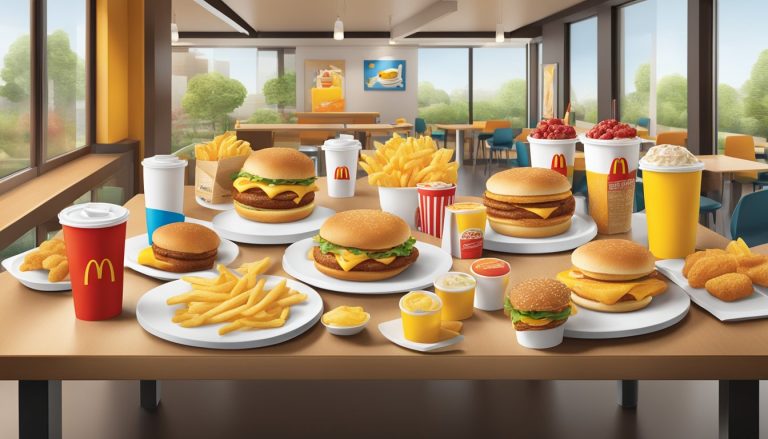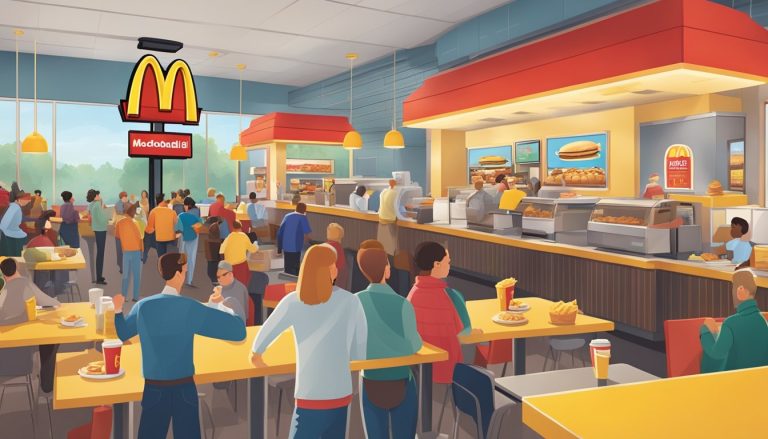McDonald’s journey into the world of coffee has been nothing short of remarkable. What began as a simple offering to complement their fast-food menu has transformed into a global coffee powerhouse. The introduction of McCafé in the early 2000s marked a pivotal moment, elevating McDonald’s from a quick-service restaurant to a serious contender in the specialty coffee market.
This evolution wasn’t just about adding new menu items. McDonald’s invested in high-quality Arabica beans, trained baristas, and created a café-style experience within their existing restaurants. The McCafé concept quickly gained traction, expanding from its initial launch in Chicago to become a staple across the United States and around the world.
Today, McCafé offers a wide range of coffee options, from basic brews to lattes, cappuccinos, and mochas. This diversification has attracted a broader customer base and solidified McDonald’s position in the competitive coffee industry. The company’s commitment to quality and convenience has resonated with consumers, turning many fast-food patrons into loyal coffee enthusiasts.
A Brief History of McDonald’s Coffee
McDonald’s journey into the coffee industry spans several decades, transforming from a simple hot beverage offering to a global coffee powerhouse. This evolution reflects changing consumer tastes and the company’s strategic expansion into the competitive coffee market.
Origins of McDonald’s Coffee
McDonald’s began serving coffee in the early 1970s as a basic hot beverage option to complement its breakfast menu. The coffee was initially sourced from various suppliers and lacked consistency across locations. In 1983, McDonald’s partnered with Gaviña Gourmet Coffee Roasters to improve quality and standardize its coffee offerings.
Gaviña, a family-owned business with roots in Cuba dating back to 1870, became a key supplier for McDonald’s. This partnership marked a significant step in enhancing the fast-food chain’s coffee reputation. McDonald’s focused on using 100% Arabica beans, aiming to compete with established coffee shops.
Introduction of McCafé
McCafé launched in Melbourne, Australia in 1993, marking McDonald’s entry into the specialty coffee segment. The concept aimed to create a café-style experience within existing restaurants. McCafé offered a wider range of coffee drinks, including lattes, cappuccinos, and mochas.
The success in Australia led to global expansion. Europe embraced the McCafé concept in the early 2000s. The United States saw its first McCafé in Chicago in 2001. By 2006, McCafé had become a recognized brand within the McDonald’s portfolio.
Expansion and Growth
McCafé’s rapid growth transformed McDonald’s into a major player in the coffee industry. By 2011, McCafé was available in over 32,000 locations worldwide. The menu expanded to include iced coffees, frappes, and seasonal specialties.
In 2009, McDonald’s partnered with Newman’s Own to offer organic coffee in select U.S. locations. This move catered to increasingly health-conscious consumers. McDonald’s also focused on sustainability, committing to sourcing 100% of its coffee from sustainable sources by 2020.
The company’s coffee sales grew significantly, with McCafé becoming a multi-billion dollar brand. This success positioned McDonald’s as a formidable competitor to established coffee chains, capturing a significant share of the global coffee market.
Coffee Sourcing and Sustainability

McDonald’s has made significant strides in sustainable and ethical coffee sourcing. The company has implemented initiatives to support coffee growers and protect the environment.
Ethical Sourcing Practices
McDonald’s prioritizes ethical sourcing for its coffee beans. The company works directly with farmers to ensure fair wages and improved working conditions. This approach helps create long-term relationships with coffee growers.
McDonald’s also invests in training programs for farmers. These programs teach sustainable farming techniques and business skills. By empowering farmers, McDonald’s aims to improve their livelihoods and communities.
The company has set strict standards for its suppliers. These include guidelines on labor practices, environmental protection, and quality control. Regular audits help ensure compliance with these standards.
Sustainable Coffee Sourcing
In 2019, McDonald’s USA achieved its goal of sourcing 100% of its coffee sustainably, a year ahead of schedule. This milestone demonstrates the company’s commitment to eco-friendly practices.
Sustainable sourcing involves various practices:
- Water conservation
- Soil management
- Biodiversity protection
- Reduction of chemical use
McDonald’s encourages farmers to adopt these methods. The company also supports reforestation efforts in coffee-growing regions. These initiatives help protect ecosystems and combat climate change.
Partnerships and Certifications
McDonald’s collaborates with various organizations to enhance its sustainability efforts. A key partnership is with the Rainforest Alliance. Many of the coffee farms supplying McDonald’s are Rainforest Alliance Certified™.
This certification ensures:
- Environmental protection
- Social responsibility
- Economic viability
McDonald’s also works with Conservation International. This partnership focuses on preserving biodiversity in coffee-growing regions. It supports projects that protect wildlife habitats and water resources.
The company participates in industry-wide initiatives. These collaborations aim to address challenges in the coffee supply chain. They focus on issues like climate change adaptation and pest management.
Advancements in Coffee Quality

McDonald’s has made significant strides in elevating its coffee offerings. The company has focused on sourcing premium beans, introducing specialty drinks, and refining its roasting techniques to deliver a superior coffee experience.
Improvements to McDonald’s Coffee Beans
McDonald’s now uses 100% Arabica beans for its coffee. These high-quality beans are sourced from sustainable farms in Central and South America. The company has partnered with expert coffee roasters to develop unique blends that cater to diverse customer preferences.
McDonald’s also implemented rigorous quality control measures. Each batch of beans undergoes thorough testing for flavor, aroma, and consistency. This ensures that only the finest beans make it into customers’ cups.
The company has invested in training its staff to handle and brew coffee properly. This includes educating employees on optimal storage conditions to maintain bean freshness and flavor.
Introduction of High-Quality Offerings
McCafé marked a significant leap in McDonald’s coffee quality. The menu expanded to include espresso-based drinks like lattes, cappuccinos, and mochas. These additions appealed to coffee enthusiasts seeking more sophisticated options.
McDonald’s also introduced seasonal and limited-time offerings. These specialty drinks, such as pumpkin spice lattes and caramel macchiatos, helped attract new customers and keep regulars engaged.
The company began offering a premium roast coffee as its standard brew. This higher-quality option replaced the previous basic coffee, elevating the overall coffee experience for all customers.
Roasting Process and Freshness
McDonald’s revamped its roasting process to enhance coffee flavor. The company now uses a medium roast profile, which strikes a balance between acidity and body. This roasting method brings out the beans’ natural flavors without excessive bitterness.
To maintain freshness, McDonald’s implemented a strict brewing schedule. Coffee is brewed in small batches throughout the day, ensuring customers always receive a fresh cup. Any coffee not served within 30 minutes is discarded.
The company also upgraded its brewing equipment. New machines were designed to maintain optimal water temperature and pressure, resulting in a more consistent and flavorful brew.
Cultivating the McCafé Experience
McDonald’s transformed its coffee offerings through the McCafé concept, elevating the quick-service experience. This shift focused on creating a distinct atmosphere, leveraging technology, and prioritizing customer satisfaction.
McCafé Ambiance and Service
McCafé spaces within McDonald’s restaurants feature a more relaxed atmosphere compared to traditional fast-food areas. Warm lighting, comfortable seating, and café-style décor create a welcoming environment. Baristas receive specialized training to craft premium beverages and provide attentive service.
The menu expanded beyond basic coffee to include lattes, cappuccinos, and mochas. This diversification attracted a broader customer base seeking higher-quality coffee options. McCafé also introduced seasonal and limited-time offerings to keep the selection fresh and exciting.
Technological Integration in Service
McDonald’s incorporated technology to enhance the McCafé experience. Digital menu boards display vibrant images of beverages, improving visual appeal and customer decision-making. Self-service kiosks allow for customized orders, reducing wait times and increasing accuracy.
Mobile ordering through the McDonald’s app streamlined the process for customers to pre-order their favorite McCafé drinks. This integration of technology improved efficiency and catered to tech-savvy consumers seeking convenience.
Customer Engagement and Satisfaction
McCafé prioritized customer feedback to refine its offerings and service. Regular surveys and social media monitoring helped identify areas for improvement and emerging trends. The brand actively engaged with customers online, responding to inquiries and addressing concerns promptly.
Loyalty programs rewarded frequent McCafé patrons, encouraging repeat visits and fostering brand loyalty. Special promotions, such as discounted or free coffee days, generated buzz and attracted new customers to try McCafé products.
McCafé’s commitment to quality and consistency across locations ensured customers could expect the same great taste whether visiting their local restaurant or one in another city.
Evolution of the Coffee Menu
McDonald’s coffee menu has undergone significant expansion and refinement over the years, transforming from basic brews to a diverse array of options catering to evolving consumer tastes.
Classic Choices and Their Continual Appeal
McDonald’s started with simple drip coffee, which remains a popular choice today. The original brew gained a reputation for consistency and affordability. Over time, McDonald’s improved their coffee sourcing and brewing techniques to enhance quality.
Iced coffee was introduced as a refreshing alternative, quickly becoming a staple for warm weather and year-round enjoyment. These classic options continue to be top sellers due to their familiar taste and value pricing.
McDonald’s also added decaf variants to accommodate customers seeking caffeine-free options. The enduring popularity of these traditional selections demonstrates the importance of maintaining core offerings while expanding the menu.
Introduction of Specialty Coffee Beverages
With the launch of McCafé, McDonald’s entered the specialty coffee market. This move brought espresso-based drinks to the fast-food giant’s menu. Lattes, cappuccinos, and mochas became available, rivaling offerings from dedicated coffee shops.
The expansion included:
- Americanos
- Flat whites
- Macchiatos
These additions catered to coffee enthusiasts seeking more sophisticated options. McCafé also introduced customization, allowing customers to choose milk types and flavored syrups.
The inclusion of espresso drinks marked a significant shift in McDonald’s coffee strategy, positioning the chain as a competitor in the premium coffee segment.
Seasonal Favorites and Novelty Creations
McDonald’s embraced the trend of seasonal offerings, introducing limited-time beverages to generate excitement and drive sales. The Pumpkin Spice Latte became a fall favorite, while the Peppermint Mocha gained popularity during winter months.
Other innovative creations include:
- Caramel Macchiato
- Iced Caramel Latte
- Frosted Coffee
Frappés were added to compete with similar blended beverages from other chains. These frozen drinks appeal to younger customers and those seeking indulgent treats.
Recently, McDonald’s has explored health-conscious trends by testing matcha lattes in select markets. This evolution showcases the brand’s adaptability to changing consumer preferences and its commitment to menu innovation.
Adapting to Consumer Preferences
McDonald’s has transformed its coffee offerings to align with evolving consumer tastes and market demands. The company’s shift from basic brews to premium McCafé options reflects a strategic response to changing coffee culture and customer expectations.
Consumer Trends and Coffee Offerings
McCafé’s menu expansion mirrors the growing sophistication of coffee enthusiasts. The line now includes espresso-based drinks, iced coffees, and seasonal flavors. This diversification caters to various preferences, from those seeking a quick caffeine fix to those desiring a more indulgent experience.
McDonald’s has also introduced specialty coffee blends and single-origin options. These additions appeal to customers who value the nuances of different coffee varieties and origins. The company’s commitment to quality is evident in its use of 100% Arabica beans and partnerships with sustainable coffee suppliers.
To stay competitive, McCafé regularly introduces limited-time offerings. These seasonal specials, like pumpkin spice lattes or holiday-themed drinks, create excitement and encourage repeat visits.
The Role of Convenience and Accessibility
McCafé’s success hinges on its ability to provide affordable, high-quality coffee with unmatched convenience. Drive-thru options and mobile ordering allow customers to grab their favorite drinks quickly, catering to busy lifestyles.
The integration of McCafé into existing McDonald’s locations has made specialty coffee more accessible to a wider audience. This strategy has democratized coffee culture, bringing cappuccinos and lattes to areas previously underserved by dedicated coffee shops.
McDonald’s has also expanded its retail presence, offering packaged McCafé coffee in grocery stores. This move allows customers to enjoy their preferred blends at home, further solidifying brand loyalty.
By balancing quality, affordability, and convenience, McCafé has positioned itself as a formidable competitor in the coffee market. Its adaptability to consumer preferences continues to drive growth and innovation in McDonald’s beverage offerings.
Marketing and Branding Impact
McDonald’s coffee marketing strategy transformed its image from a basic fast-food offering to a premium beverage experience. The company leveraged strategic branding and innovative packaging to establish McCafé as a distinct coffee brand.
Strategic Branding Initiatives
McDonald’s launched targeted campaigns to position McCafé as a high-quality, affordable coffee option. They emphasized the use of 100% Arabica beans and introduced specialty drinks like lattes and cappuccinos. TV commercials showcased baristas crafting beverages, highlighting the brand’s commitment to quality.
Social media played a key role in engaging younger consumers. Instagram-worthy cup designs and limited-time flavor promotions generated buzz online. McCafé also partnered with influencers to reach new audiences and build credibility in the coffee space.
In-store promotions, such as free coffee days and loyalty programs, encouraged customers to try McCafé products. These initiatives helped shift perceptions and attract coffee enthusiasts who may not have considered McDonald’s for their caffeine fix.
McDonald’s Coffee Cups as Brand Ambassadors
McCafé cups became powerful marketing tools, serving as mobile advertisements. The company redesigned its cups with sleek, modern aesthetics to appeal to coffee connoisseurs. Bold logos and eye-catching graphics made the cups instantly recognizable.
McDonald’s introduced seasonal cup designs, creating collectible items and fostering customer engagement. Holiday-themed cups became annual traditions, generating anticipation and social media shares.
The cups also featured QR codes linking to nutritional information and promotional offers. This interactive element provided added value and encouraged repeat purchases. McDonald’s commitment to sustainability was reflected in the gradual shift to recyclable and compostable cup materials, appealing to environmentally conscious consumers.
The Broader Coffee Ecosystem

McDonald’s coffee journey extends beyond its own stores, influencing and being influenced by the wider coffee industry. The company has positioned itself as a major player in the coffeehouse landscape while also tapping into external expertise to enhance its offerings.
McDonald’s in the Coffeehouse Chain Landscape
McDonald’s McCafé brand has emerged as a formidable competitor in the coffeehouse chain market. By offering specialty coffee drinks at competitive prices, McCafé has captured a significant share of coffee consumers. The brand competes directly with established chains like Starbucks and Dunkin’.
McCafé’s success lies in its accessibility and convenience. With thousands of locations worldwide, it provides coffee shop quality beverages without the need for a separate trip. This strategy has helped McDonald’s attract a new demographic of coffee-focused customers.
The introduction of McCafé has also prompted other fast-food chains to improve their coffee offerings, raising the overall quality of coffee in the quick-service restaurant sector.
Collaborations and Coffee Production Expertise
To elevate its coffee quality, McDonald’s has forged partnerships with coffee experts and suppliers. The company works with established coffee roasters to develop custom blends that meet its specific taste and quality standards.
McDonald’s has invested in sustainable coffee sourcing practices. It collaborates with organizations like the Rainforest Alliance to ensure ethical and environmentally responsible coffee production. This commitment extends to supporting coffee farmers and communities in coffee-growing regions.
The company has also tapped into barista expertise to train its staff in proper coffee preparation techniques. This focus on skill development has improved the consistency and quality of McCafé beverages across locations.
These collaborations have allowed McDonald’s to gain valuable insights into coffee production and trends, helping the company stay competitive in the ever-evolving coffee market.




